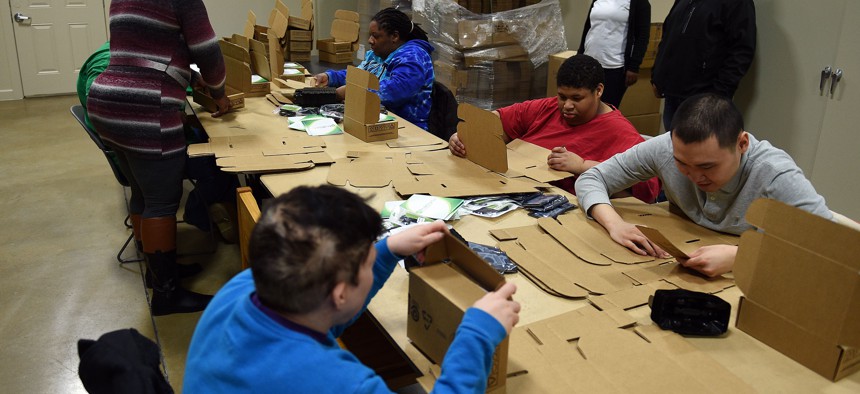States Vote to End Subminimum Wage

Workers take care of the shipping of orders at The Chimes, a facility in Baltimore that employed people with disabilities for subminimum wage in 2016. Maryland has since outlawed subminimum wage. Photo by Astrid Riecken For The Washington Post via Getty Images
Advocates for people with disabilities see progress in leveling pay and ending work segregation.
When Virginia’s legislature voted this month to phase out the practice of paying subminimum wages to disabled people, it joined a growing movement of states and cities around the nation to end an approach that pays some as little as pennies an hour.
The effort to do away with subminimum wages for people with disabilities enjoys rare bipartisan support—even in Congress, where a bill to end the lower wages was sponsored by a Democrat and a Republican in each of the chambers.
In addition to Virginia, where the bill to end subminimum wages is awaiting the governor’s signature, another 13 state legislatures have voted to abolish the low wage for disabled people, according to the Association of People Supporting Employment First (APSE). Several other states are in various stages of proposing and considering related legislation.
Still, there are those who worry that ending the practice means disabled people won’t have any opportunities to work. The places that pay lower rates are sheltered workshops that employ people with severe intellectual disabilities who may not be able to bag groceries or perform many of the other minimum wage jobs. But the idea is to phase out these federally certified and funded workshops that segregate disabled workers and find ways to integrate them into mainstream workplaces. It mirrors a decades-long effort in public schools to mainstream children with disabilities with their peers.
“In the sheltered workshops, [people with disabilities] have friends and it’s less stressful. They like it. The other side argues that they’ve never worked anywhere else,” said Nanette Goodman, who focuses her work on disability employment issues as director of research at the Burton Blatt Institute at Syracuse University. “There are people who believe that everybody—no matter their disability—can work in competitive employment with appropriate support.”
Nationwide, APSE reports, there has been a steady decline in the number of active certificates necessary for operating employment workshops and the number of individuals served by the workshops has declined.
“In 2016, there were 2,275 active certificates employing 241,265 individuals earning subminimum. In July 2019, these numbers dropped to 1,316 certificates employing 105,006 individuals. This is a 56% decrease in certificates and 42% decrease in individuals served,” according to an APSE report on the trends and current status of 14(c)—the certificates to run sheltered workshops..
Given how relatively recent these changes in policy were enacted, APSE’s report states that it’s not possible to accurately assess the impact on the lives of people with disabilities, but that “despite the obvious limitations of available data, positive trends can be observed.”
Goodman has a nephew who is severely intellectually disabled. He had to switch from a job bagging candy to shredding paper in a sheltered workshop because he was eating too much of the candy. Her nephew’s family worries about him being able to work in an integrated environment.
In the workshops, a system paid for by Medicaid, if workers are able to do about half the amount of work as a non-disabled person in an hour, then they earn half the pay, Goodman said. If they can perform about one-tenth of the work, they earn one-tenth the pay and so on.
But the workshops were never meant to be places where disabled people worked for their entire lives. “For people who couldn’t make it in competitive employment, the workshops were meant to be sheltered training grounds. But they never got out,” Goodman said.
The law allowing subminimum wage for people with disabilities dates back to 1938. “It’s a very antiquated notion,” said Michael Morris, a senior adviser at the Burton Blatt Institute at Syracuse. “It was done with good intentions. It was not, back then, a method of discriminating against people with disabilities. But we’ve come such a long way. It really is discriminatory.”
Morris acknowledges that some families of workers with disabilities do worry about where their sons or daughters will find work. “It’s not an either-or. We’re reevaluating work requirements and rethinking how people with varying disabilities could still be productive.”
The bill in Congress, if approved, would distribute $300 million in grants to groups that hold certificates to run workshops to develop new models that would replace the segregated approach, Morris said. “We need to rethink how people with varying disabilities could still be productive.”
Goodman stresses that simply increasing pay for people with disabilities won’t address the important goal of integrating disabled people into the wider world. “If you just pay people more, that doesn’t meet the goal of what people are trying to do,” she said. “That’s the vision.”





